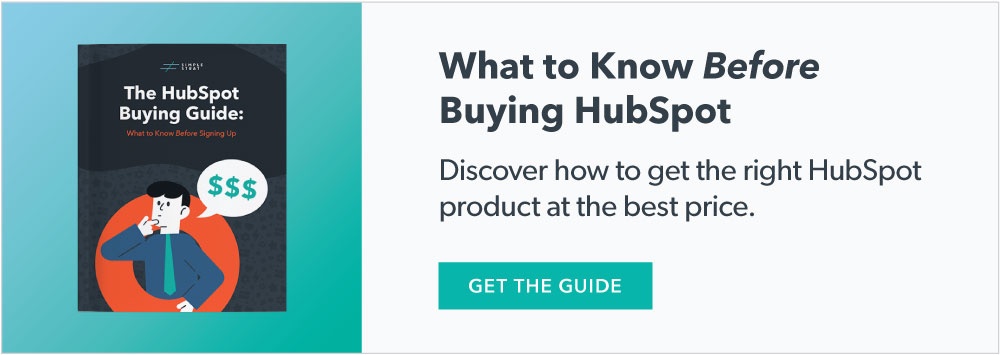How many actions does it take before a lead converts into a customer?
That’s a trick question, kind of like the number of licks to get the center of the tootsie pop.
It’s hard to answer because it varies A LOT.
Some leads may be ready for a call or demo today. Others are merely exploring the answers to a question that’s still far removed from your actual solution or product.
We might call these leads at the “top of the funnel”, but in layman’s terms, it just means you need to “date” a while longer before they’re ready to talk marriage.
Ok, so how exactly do you nudge these contacts to get closer to a sale?
That’s where lead nurturing, or delivering a series of emails (and/or even SMS or messages on other platforms) comes in. For the purposes of this article, we’re going to focus on email lead nurturing. This can be set up easily on an automation platform like HubSpot.
What is B2B Lead Nurturing?
B2B Lead Nurturing is designing a group of emails that are meant to “nurture” a contact or lead into becoming a customer of your company. Usually there is a handful of these emails that get sent over time, in response to a particular action that the contact took in your customer journey.
Examples of B2B Lead Nurturing:
- Enrolling a contact in lead nurturing flow after they downloaded an ebook or piece of gated content from your website.
- Following up with a series of emails to attendees of a webinar if they haven’t booked a bottom of funnel consultation or demo
- Enrolling a contact in a drip sequence after they joined your email list, to deliver them the top 5 performing articles from your website that you know they would enjoy
As you can see from the examples above, these are many use cases for this.
And for the purposes of this article, we’re going to use the words “lead nurturing” and “drip emails” interchangeably – not because they’re necessarily the same thing, but across the web we notice people use these words to ask for the same thing, and that is this:
To move leads along in the buying journey.
Sometimes they move quickly, and sometimes they stay in this nurturing phase for a long time. The goal of the matter is, however, to continue to provide content to them that’s highly relevant, related to the content they first engaged with, and points to a next step in their decision to solve their problem.
Where B2B Lead Nurturing Fails
We’ve all had this happen to us. You download an ebook from a website, and then get hammered to schedule a meeting right away. That’s not lead nurturing. That’s spamming!
Or perhaps you’ve attended a webinar, and then all of a sudden you’re getting emails for a product that you know nothing about.
#fail
B2B lead nurturing is most effective (and in our opinion should only be done this way) when you take into account three variables:
- Original intent. Why did they initially engage with your brand? What problem were they trying to solve?
- Desired outcome. Based on that problem, what desired outcome do you think they are hoping to achieve?
- Obstacles or barriers. What obstacles or barriers exist to them realizing that outcome?
Answering these three questions will help you design effective lead nurturing. And as you may soon realize, you’re going to need great content to address these topics in email.
No content? No nurturing.
B2B Lead Nurturing Campaign Example
To put this into practice, let’s take the following use case:
Example company: Leadership consulting company
Action initial lead took: Visits your website and downloads a guide to building an employee development plan.
Original intent:
There are a number of reasons someone may download an employee development guide, but this may include:
- Current employee is not performing well and they’re hoping this will alleviate the issue
- They recognize the value of employee development plans but aren’t sure where to start
- They have high performing team members and realize that if there isn’t a clear path for development, they may lose those team members
- Their boss asked them to create a development plan and they’re researching how to do that
All of those reasons are a bit different, including who’s in the power seat as well. As you keep those things in mind, some ideas for content in your lead nurturing campaign may be:
Email #1
Thank you for downloading – here are 3 key takeaways you’ll find in the guide.
*The reason for doing this is that people have great intentions in downloading content, but often don’t get into the full piece right away (if ever!) – so pulling out three key insights right in the body of the email is a great way to provide value and demonstrate authority on the subject.
Email #2
Employee development template – because they’ve downloaded the employee development guide, it’s assumed that they may need to build one.
What better way to help them do this them to offer them a word or excel template to make this possible. It’s quick, actionable, and highly relevant to the topic at hand.
Email #3
Invitation to on demand webinar talking about best practices to develop your employees. This isn’t necessarily about the plan itself, but best practices to help team members level up their skills and talents.
As a leadership company, this is something that you should have in your library as its highly relevant to all prospects. Include a soft CTA to schedule a call if they want to chat specifically about how those best practices can be put into practice in their company.
Email #4
Invitation to a call with a leadership consultant on your team. Now that you’ve sent a few emails to demonstrate authority on the subject, and deliver value, offer specific insights to them that may be helpful.
Showcase how you’ve been able to help 3 companies with challenges a, b, and c and perhaps you can help them too. CTA is schedule a free call.
Email #5
Ask if developing their employees is still a top priority for 2023. This prompts a response especially if asked in reverse, such as “Employee development not a priority right now?”. Use language that will help remove the mental load, such as giving them options – we can help in 3 ways – classes, coaching, and workshops*
*Reminder, we’re making this up for the sake of demonstration here. No real company was used in this example!
Email #6
The single question email – Ideas welcome. Acknowledge that now may not be the right time for them to solve this problem in their company, but you welcome any ideas on how we can help. Let them know they’re welcome to visit the website to learn more, and hope they’ve enjoyed the resources we’ve shared with them.
Then after this email, move them back into recycle leads for your SDR team, or simply “not interested” (or however your lead statuses may be set up in HubSpot or a similar CRM).
Your content library can help or hurt your efforts
As you can see, from the example above, lead nurturing only works well with specific content to move someone along from their initial problem to the point that your company can help.
If you don’t have those content pieces, you run the risk of simply sending emails that go right for the sale (or right for the jugular as we say!). They feel attacked, moving from a place of value to being in the place of being pitched a sale.
Don't overlook the challenges
Going back to the 3 questions that we asked to set up the campaign, we discussed the original intent, but keep in mind the barriers and challenges that may exist for them to get to their desired outcome.
This may include not knowing what it costs to engage a company like yours – so even if you have great emails, if there is no hint of investment range or cost on your website, this may prevent them from scheduling a call.
Also, no one wants to take a risk on a company without knowing they’re going to get their problem solved effectively – which is where case studies and reviews come in.
These are critical pieces that live outside your lead nurturing campaign, but can impact the effectiveness (your content works together, remember!).
Final Tips for Your B2B Lead Nurturing Campaign
These tips are demonstrated a bit in the example above, but need to be called out as a checklist for success.
- One email, one topic. Don’t try to cover two topics in an email. It’s not going to work.
- Be brief. Concise language is essential. People may be reading these on their mobile phone and if they have to scroll more than 3 times, it’s too long. Maybe even 2 scrolls is ideal.
- Don’t force the topics together. Make sure that the topics blend and progress naturally, like they would in a conversation.
- Personalize the emails. Use personalization tokens based on fields in your CRM. This is also where the strategy of what info to capture on what lead forms needs to be discussed between your marketing and sales teams.
- Be valuable. The goal is ultimately to convert a customer, but people can smell desperation a mile away. Focus on driving value and remaining top of mind as a company/rep that can answer questions and has expert insights. The sale ask then becomes an extension of that value rather than a forced ask for a meeting.
Get the free B2B Lead Nurturing Template
If you’d like to get started today, we suggest using this free lead nurturing template to sketch out the campaign at a glance and help you determine what content gaps may exist before putting the campaign into action.
This free template covers the 3 key questions, the email purpose and content overview, and then action steps you need to put this into place in your marketing automation platform (HubSpot is our MAP of choice, but this will work in others of course).
If you need help deploying this or would like to outsource the building of your B2B lead nurturing campaigns, let us know how we can help or book a free consultation call.


